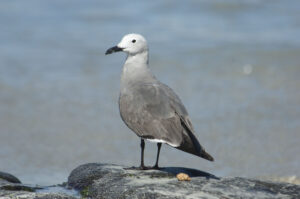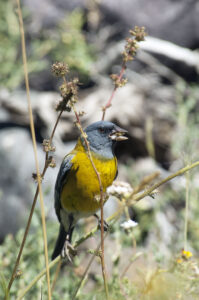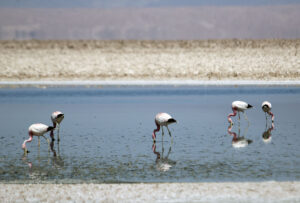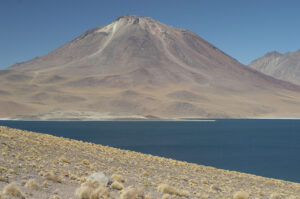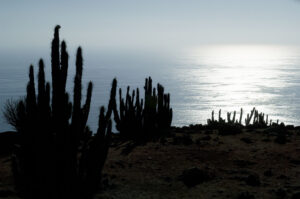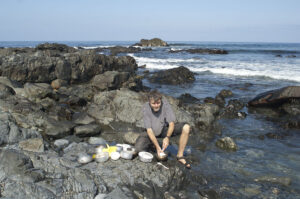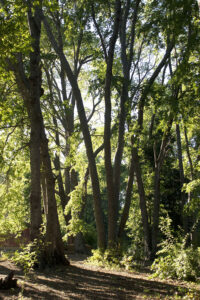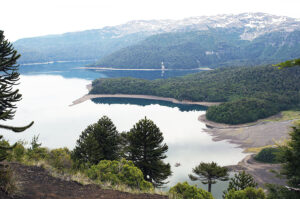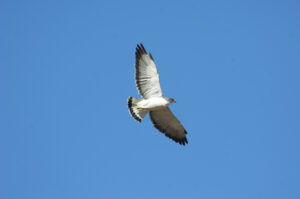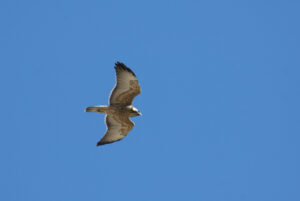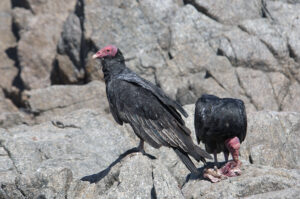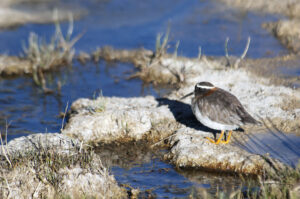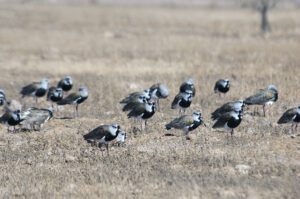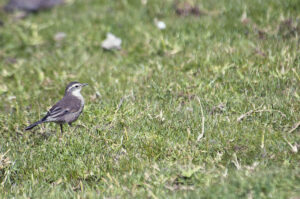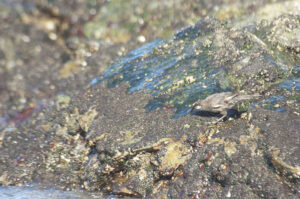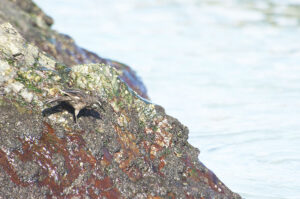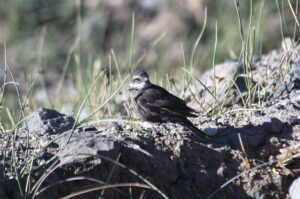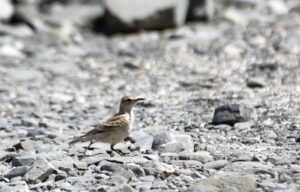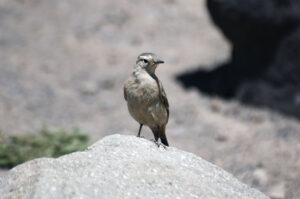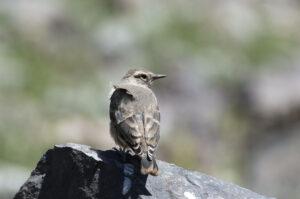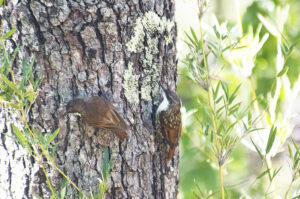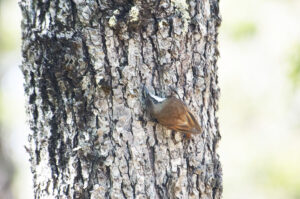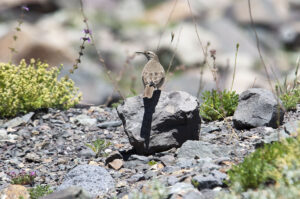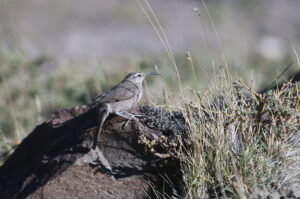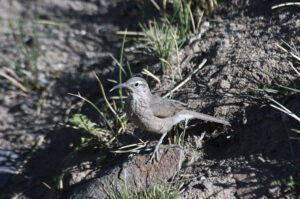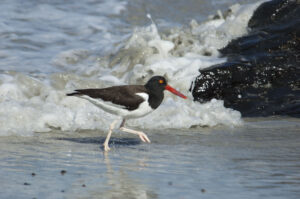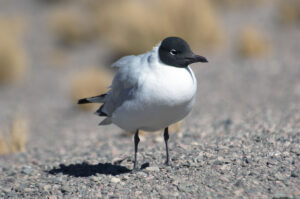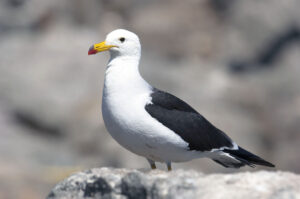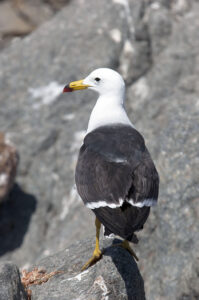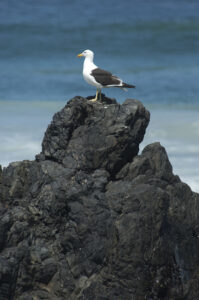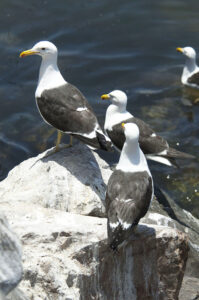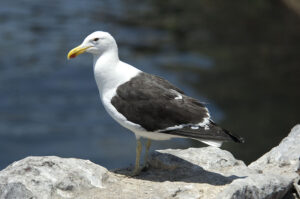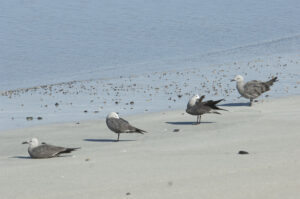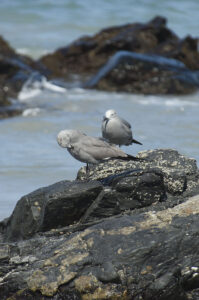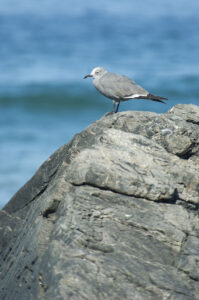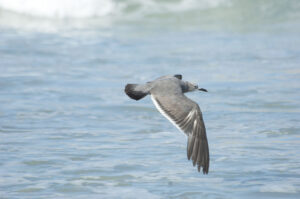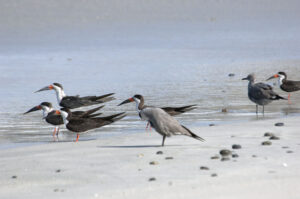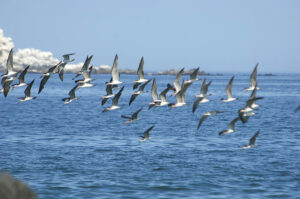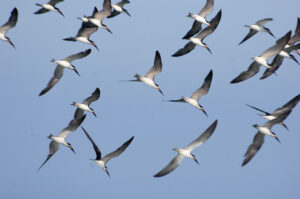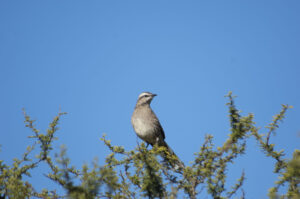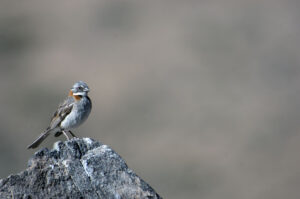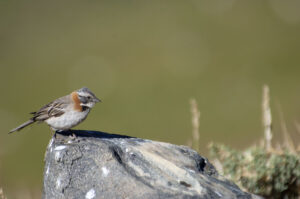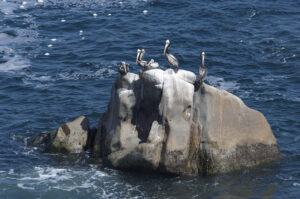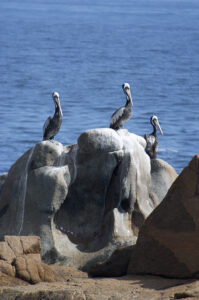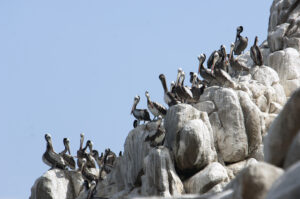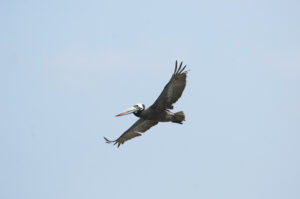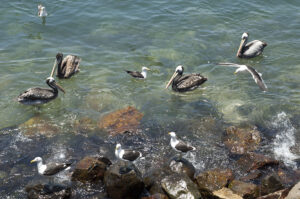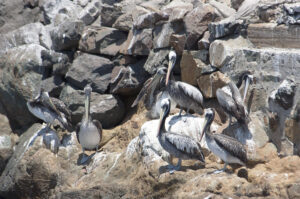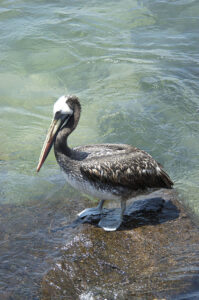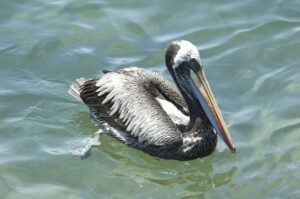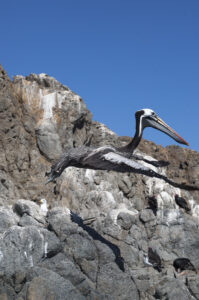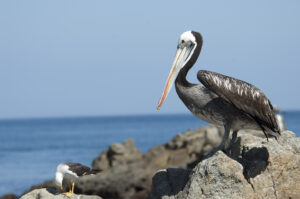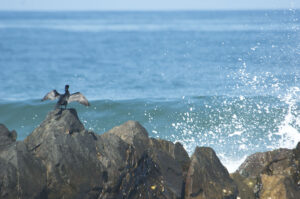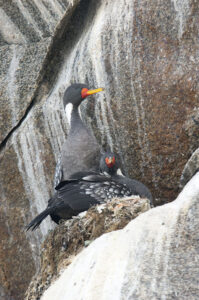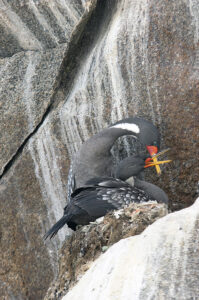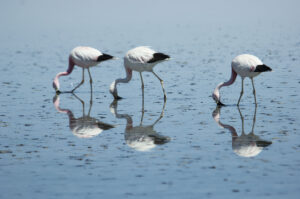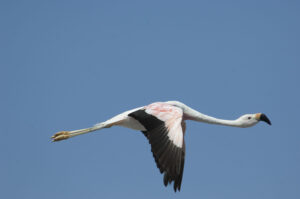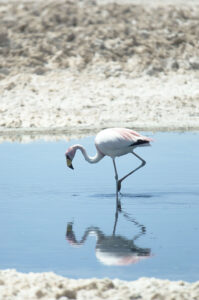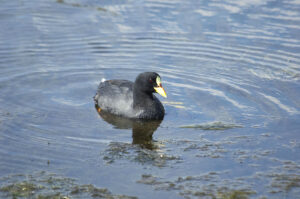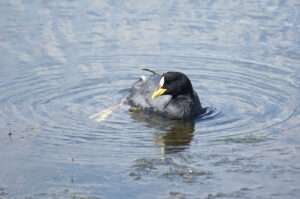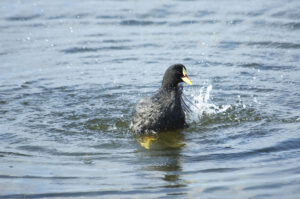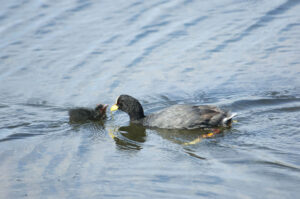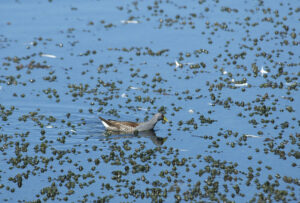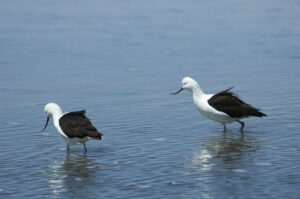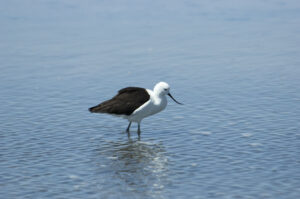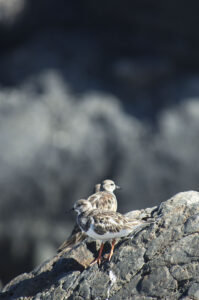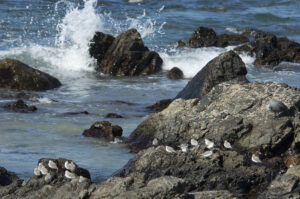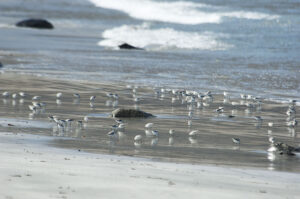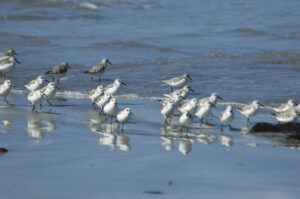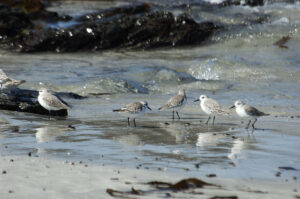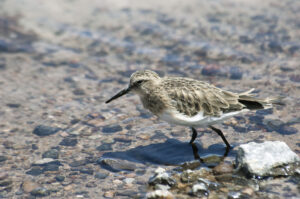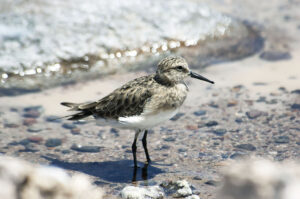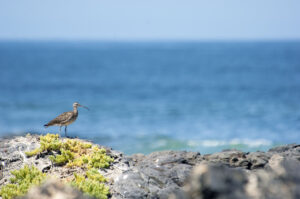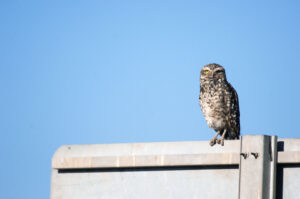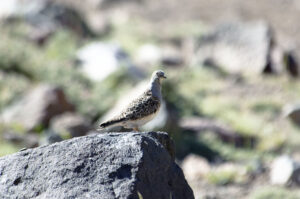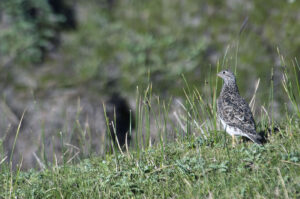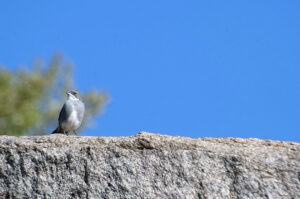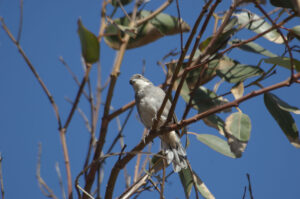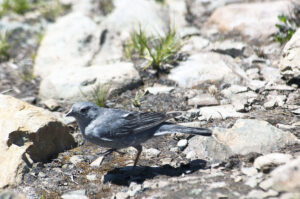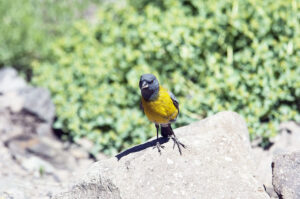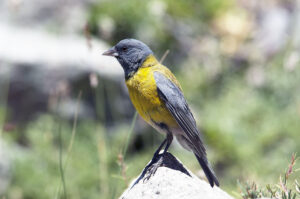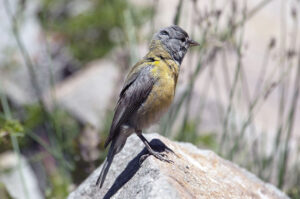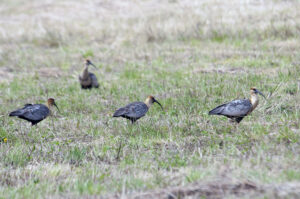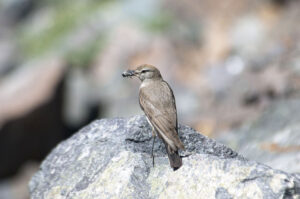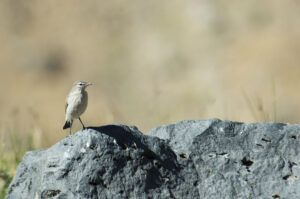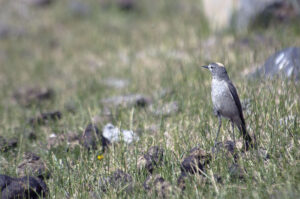Birds in Chile
Black-necked swan (Cygnus melancoryphus), Laguna El Peral. (Photo copyright © by Kaj Halberg)
Grey gull (Leucophaeus modestus), Pan de Azucar National Park. (Photo copyright © by Kaj Halberg)
Male grey-hooded sierra-finch (Phrygilus gayi), eating seeds, Monumento Natural El Morado. (Photo copyright © by Kaj Halberg)
The pictures on this page were taken during a one month’s stay in Chile in January 2011, together with Lars Skipper.
Birding areas visited
Salar de Atacama
This area constitutes a part of the huge Los Flamencos National Reserve, which covers 7 sectors in the Atacama Desert, altogether covering an area of 740 square km. Salar de Atacama is the largest salt flat in Chile, about 100 km long and 80 km wide, situated about 55 km south of the town of San Pedro de Atacama. This wetland has no outlet, and the water is extremely salty. Here we observed Andean flamingo (Phoenicoparrus andinus), James’ flamingo (Phoenicoparrus jamesi), Andean avocet (Recurvirostra andina), and Baird’s sandpiper (Calidris bairdii).
Feeding Andean flamingos (Phoenicoparrus andinus), Laguna de Chaxas, Salar de Atacama. (Photo copyright © by Kaj Halberg)
Lagunas Miscanti y Miniques
These gorgeous lakes are also a part of the Los Flamencos National Reserve, located just south of Salar de Atacama. They are situated in a dramatic setting, beneath the Miñiques Volcano and Cerro Miscanti. Once upon a time, there was only one lake, but a lava flow from an eruption of Miñiques formed a barrier between the two present lakes.
In these lakes, we observed Andean gull (Chroicocephalus serranus).
Laguna Miscanti and the Miniques Volcano. (Photo copyright © by Kaj Halberg)
Pan de Azucar National Park
This coastal park, located north of the town of Chanaral, covers an area of 438 square km. It is a very dry area, which receives the major part of the precipitation in the form of fog from the sea. The park has its name after one of the hills in the area, called Monte Pan de Azucar (‘Sugar-loaf Mountain’), which was named due to its conical shape, resembling an old sugarloaf of the 19th Century,
In this area, we observed a large number of coastal birds, including seaside cinclodes (Cinclodes nigrofumosus), band-tailed gull (Larus belcheri), grey gull (Leucophaeus modestus), black skimmer (Rynchops niger), and Peruvian pelican (Pelecanus thagus).
Eulychnia iquiquensis is a common cactus species in Pan de Azucar National Park. (Photo copyright © by Kaj Halberg)
Llanos de Challe National Park
Another park at the Pacific coast in the Atacama Desert, near the town of Carrizal Bajo. Like Pan de Azucar, this very dry area is moistened by fog from the sea. In this park, we observed common miner (Geositta cunicularia) and various water birds, including black-necked swan (Cygnus melancoryphus), red-gartered coot (Fulica armillata), and Hudsonian whimbrel (Numenius hudsonicus).
Lars, cleaning dishes in the sea, Llanos de Challe National Park. (Photo copyright © by Kaj Halberg)
Valle del Encanto
‘The Enchanted Valley’ is located in a ravine about 20 km west of the city of Ovalle. In 1946, it was discovered that this area contained various archaeological remains from the El Molle Culture (app. 300-700 A.D.), including petroglyphs and pictographs, and also traces of hunting groups from about 2000 B.C.
The valley is a green oasis in an otherwise dry area, dominated by vegetation of the large cactus species copao (Eulychnia acida). In this area, we observed variable hawk (Geranoaetus polyosoma), Chilean mockingbird (Mimus tenca), common diuca-finch (Diuca diuca), and southern lapwing (Vanellus chilensis).
Large growth of copao, Valle del Encanto. (Photo copyright © by Kaj Halberg)
La Campana National Park
An area of dry shrub forest, covering about 80 square km, located about 60 km north-west of Santiago. Here we observed giant hummingbird (Patagona gigas).
Shrub forest, La Campana National Park. (Photo copyright © by Kaj Halberg)
Embalse El Yeso
A huge artificial lake, located in the Andes about 60 km south-east of Santiago. In the grasslands around this reservoir, we observed a large number of birds, including diademed sandpiper-plover (Phegornis mitchellii), grey-breasted seedsnipe (Thinocorus orbignyianus), ochre-naped ground-tyrant (Muscisaxicola flavinucha), scale-throated earthcreeper (Upucerthia dumetaria), and buff-winged cinclodes (Cinclodes fuscus).
Mountains near Embalse El Yeso. (Photo copyright © by Kaj Halberg)
Monumento Natural El Morado
This is a protected area of glaciers and glacial lakes, situated about 93 km south-east of Santiago. Bird life is not particularly rich. We observed rufous-banded miner (Geositta rufipennis), scale-throated earthcreeper (Upucerthia dumetaria), grey-hooded sierra-finch (Phrygilus gayi), and white-browed ground-tyrant (Muscisaxicola albilora).
Monumento Natural El Morado. (Photo copyright © by Kaj Halberg)
Reserva Nacional Altos de Lircay
This nature reserve, covering about 120 square km, is located some 80 km south-east of the city of Talca. It harbours 3 major rivers, the Claro and two of its tributaries, the Lircay and the Blanquillo.
The reserve is home to 7 out of the 10 species of southern beeches (Nothofagus) that occur in Chile, and also to several rare and threatened animals, including burrowing parrot (Cyanoliseus patagonus) and Molina’s hog-nosed skunk (Conepatus chinga). We only observed few bird species in this area, including white-throated treerunner (Pygarrhichas albogularis) and plumbeous sierra-finch (Geospizopsis unicolor).
Forest of roble (Nothofagus obliqua), Reserva Nacional Altos de Lircay. (Photo copyright © by Kaj Halberg)
Conguillio National Park
This huge park, covering 608 square km, is located in the Andes, about 70 km east of the city of Temuco. It is an area of wild mountain landscapes, including the spectacular Llaima Volcano, and a number of lakes. The park is home to extensive forests of Araucaria araucana and Nothofagus species. Its name derives from a Mapuche word, meaning ‘water with Araucaria seeds’.
Birdlife in these forests is not particularly rich. We observed Magellanic woodpecker (Campephilus magellanicus), Chilean flicker (Colaptes pitius), slender-billed parakeet (Enicognathus leptorhynchus), common miner (Geositta cunicularia), rufous-collared sparrow (Zonotrichia capensis), and scale-throated earthcreeper (Upucerthia dumetaria).
In Laguna Captrén, a little jewel of a lake, we observed flying steamer duck (Tachyeres patachonicus), Chilean pintail (Anas georgica ssp. spinicauda), Andean duck (Oxyura ferruginea), white-winged coot (Fulica leucoptera), and ashy-headed goose (Chloephaga poliocephala).
Lago Conguillio, Conguillio National Park. (Photo copyright © by Kaj Halberg)
Laguna Captrén and Llaima Volcano, Conguillio National Park. (Photo copyright © by Kaj Halberg)
Huerquehue National Park
This park, whose name is pronounced werkewe, is located in the foothills of the Andes, about 145 km south-east of Temuco. It covers an area of 125 square km, consisting primarily of temperate rainforest.
In the small Lago Chico, we observed a pair of bronze-winged ducks (Speculanas specularis) with ducklings.
Lago Tinquilco and Villarrica Volcano, Huerquehue National Park. (Photo copyright © by Kaj Halberg)
Bird list
Families, genera, and species are presented in alphabetical order. When writing the text, I have relied heavily on the website ebird.org and various pages on Wikipedia. The nomenclature largely follows the IOC World Bird List (worldbirdnames.org). Information about etymology is often based on J.A. Jobling, 2010. The Helm Dictionary of Scientific Bird Names, Christopher Helm, London.
In case you encounter any errors on this page, I would be grateful to hear about it. You can use the address at the bottom of the page.
Accipitridae Hawks, eagles, and allies
A huge family, comprising about 66 genera and c. 250 species of small to large raptors, distributed worldwide, with the exception of Antarctica.
The family name is derived from the Latin accipiter (‘hawk’), from accipere (‘to grasp’), naturally alluding to the sharp talons.
Geranoaetus South American buzzards
This genus contains 3 species, distributed from coastal Texas and the Rio Grande Valley southwards through Mexico, Central America, and western South America to Tierra del Fuego and the Falkland Islands. They were previously included in the genus Buteo.
The generic name is derived from Ancient Greek geranos (‘crane’) and aetos (‘eagle’). What the crane part refers to is hard to see.
Geranoaetus polyosoma Variable hawk
As its name implies, the plumage of this bird is variable. Divided into 4 subspecies, it is widespread and rather common in open habitats, living mainly in Andean Highlands, from Columbia southwards to Tierra del Fuego, and also in the Falkland Islands and the Juan Fernández Islands. The taxonomy of this species is disputed, and some authorities split it into 3 separate species.
The specific name is derived from Ancient Greek polios (‘grey’) and soma (‘body’).
These pictures show the extremely variable plumage of the variable hawk, both from Valle del Encanto, Ovalle. (Photos copyright © by Kaj Halberg)
Anatidae Ducks, geese, and swans
At present, this large worldwide family contains 43 genera with about 146 species.
Chloephaga
A small genus of 5 species of geese, restricted to southern South America, the Falkland Islands, and South Georgia.
The generic name is derived from Ancient Greek khloe (‘young green grass’) and phagein (‘to eat’).
Chloephaga poliocephala Ashy-headed goose
This rather large goose breeds in mountains of the southernmost parts of South America, wintering in lowlands a little further north.
The specific name is derived from Ancient Greek polion (‘grey’) and kephale (‘head’).
A pair of ashy-headed goose with goslings, Laguna Captrén, Conguillio National Park. (Photo copyright © by Kaj Halberg)
Cygnus Swans
A genus of 6 long-necked birds, distributed on all continents except Antarctica. Genetic research indicates that the coscoroba swan (Coscoroba coscoroba) of South America is not a true swan, but more closely related to geese or shelducks.
The generic name is a Latinized form of the classical Greek word for swan, kyknos.
Cygnus melancoryphus Black-necked swan
This smallish swan breeds in lakes, marshes, and lagoons in Chile, southern Argentina, and Uruguay, including Tierra del Fuego and the Falkland Islands. It is mainly sedentary, but birds in Tierra del Fuego are migratory, in winter straying as far north as Paraguay and southern Brazil.
It has a length of up to 1.2 m, a wingspan of up to 1.7 m, and a weight of up to 8.7 kg.
The total number is unknown, but the population in Argentina is estimated at over 50,000 individuals.
The specific name is derived from Ancient Greek melas (‘black’) and koryphe (‘head’).
Black-necked swans, Carrizal Bajo, Llanos de Challe National Park, Atacama. (Photos copyright © by Kaj Halberg)
Black-necked swan preening, Laguna El Peral. (Photo copyright © by Kaj Halberg)
Speculanas specularis Bronze-winged duck
This species, also called spectacled duck, is the only member of the genus. It lives in central and southern Chile and adjacent parts of Argentina, restricted to forested rivers and lakes in the lower Andes. Unlike most other dabbling ducks, the sexes are alike.
The generic name is derived from the Latin speculum (‘mirror’) and anas (‘duck’), the specific name also from speculum, both referring to the bronze-coloured speculum of this bird. The common name spectacled duck was given in reference to the large white patch in front of the eye. Locally, it is known as pato perro (‘dog-duck’), alluding to the harsh, barking call of the female.
Pair of spectacled duck with ducklings, Lake Chico, Huerquehue National Park. (Photo copyright © by Kaj Halberg)
Cathartidae New World vultures
This family contains 5 genera with 5 species of vultures and 2 species of condors, distributed from southern Canada southwards to southern South America.
Cathartes
A genus with 3 species.
The generic name is a Latinized form of Ancient Greek kathartes (‘purifier’), referring to these birds getting rid of decomposing carcasses in nature.
Cathartes aura Turkey vulture
This bird is widespread and common, found from southern Canada southwards to the southernmost tip of South America. It lives in a variety of habitats, including forests, shrublands, agricultural areas, and deserts. The northernmost populations migrate south in the winter.
The specific name is Latin, meaning ‘golden’, presumably alluding to the sometimes yellowish head of the two other members of the genus. Once upon a time, they were probably all regarded as a single species. The head of the turkey vulture is always red, similar to the colour of the head of the male turkey.
Turkey vultures, feeding on fish offal, Pan de Azucar National Park. (Photo copyright © by Kaj Halberg)
Charadriidae Plovers and lapwings
This family of small to medium-sized waders comprise about 10 genera with about 65 species. They are distributed almost worldwide, the vast majority near wetlands.
Phegornis mitchellii Diademed sandpiper-plover
This beautiful wader, the only member of the genus, is found very locally in the high Andes, living in marshes and grasslands, and along lakeshores and rivers, breeding at elevations between 3,500 and 5,000 m and wintering around 2,000 m. It is distributed from central Peru southwards to southern Bolivia, central Chile, and north-western Argentina.
The generic name is derived from Ancient Greek phengos (‘light’ or ‘glow’) and ornis (‘bird’), alluding to the splendour of this bird. The specific name was applied in honour of English zoologist David William Mitchell (1813-1859), who was secretary of the Zoological Society of London 1847-1859.
Diademed sandpiper-plover, Embalse El Yeso. (Photos copyright © by Kaj Halberg)
Vanellus Lapwings
This genus contains 24 species of medium-sized waders, distributed in most parts of the globe.
The generic name is Latin, diminutive of vannus (‘winnowing fan’), referring to the whirring sound, produced by the wings of the northern lapwing (V. vanellus) during courtship display.
The common name is derived from Old English hleapewince, of hleapan (‘to leap’) and wince (‘move rapidly’), likewise alluding to the courtship display of the northern lapwing, when the male twists and turns at a tremendous speed over the meadows.
Vanellus chilensis Southern lapwing
A common and widespread resident throughout South America, except in dense forests, the higher parts of the Andes, and the desert areas along the west coast. In later years, it has been expanding its range to Central America and some Caribbean islands. It is the national bird of Uruguay.
Southern lapwings, Valle del Encanto, Ovalle. (Photo copyright © by Kaj Halberg)
Furnariidae Ovenbirds
A large family, containing 70 genera with about 315 insectivorous birds, found from Mexico southwards to southern South America.
The family was named from the elaborate, vaguely oven-like clay nest, built by the members of the genus Furnarius, called the horneros, derived from the Spanish horno (‘oven’).
Cinclodes Cinclodes
This genus, containing about 15 species, is distributed across southern South America. They are terrestrial birds of open habitats, typically found near water, where they feed on small invertebrates. Many of the species are notoriously difficult to identify. If I have misidentified some of the following 3 species, please let me know. You can use the address at the bottom of the page.
The generic name is derived from Ancient Greek kinklos, a term used for some kind of waterside bird, and oides (‘resembling’).
Cinclodes fuscus Buff-winged cinclodes
A fairly common species in southern South America, usually found in pastures near water, or along lakes, from the Andes down to the coast. In the Andes, it is often encountered in the same areas as the grey-flanked cinclodes (below), but has a plain breast versus clear streaking on grey-flanked. Its broad buff wing stripe is shown on its raised wings during song display.
The specific name is Latin, meaning ‘brown’, presumably referring to the wing stripe.
Buff-winged cinclodes, Embalse El Yeso. (Photo copyright © by Kaj Halberg)
Cinclodes nigrofumosus Seaside cinclodes
This bird is restricted to rocky coasts of northern and central Chile, most often observed feeding in the intertidal zone. It is rarely seen away from the sea, although it may be encountered on sandy beaches at river mouths. It may be identified by a narrow whitish eyebrow, bold white streaks on the breast, and a rather stout bill, utilized to smash open small crabs.
The specific name is derived from the Latin niger (‘black’) and fumosus (‘smoked’), from fumus (‘smoke’), thus ‘smoky-black’.
Seaside cinclodes, feeding on a coastal rock, Pan de Azucar National Park. (Photos copyright © by Kaj Halberg)
Cinclodes oustaleti Grey-flanked cinclodes
Another fairly common bird in the high Andes of central Chile and adjacent Argentina, where it is found in bogs, at lakeshores, and along streams, usually near rocks. In winter, it migrates to the coast, where it occurs on rocky beaches. Despite its name, the flanks are more brownish than greyish. It may be told from buff-winged cinclodes (above) by the white-streaked breast.
The specific name was given in honour of French zoologist Jean-Frédéric Émile Oustalet (1844-1905), among ornithologists known chiefly for his works Les Oiseaux de la Chine (1877), and Oiseaux du Cambodge, du Laos, de l’Annam et du Tonkin (1899).
Grey-flanked cinclodes, Embalse El Yeso. (Photo copyright © by Kaj Halberg)
Geositta Miners
A genus of 11 species of ground-dwelling birds, living in open country in South America, especially in the Andes and Patagonia. The common name refers to their nesting tunnels, which they dig themselves. They are often observed wagging their tail up and down.
The generic name is derived from Ancient Greek geo (‘earth’) and sitte (‘nuthatch’), thus ‘the ground-living nuthatch’, although these birds are not even distantly related to nuthatches. Presumably, the name was given in allusion to their nesting tunnels, as nuthatches breed in holes in tree trunks, the opening of which is often made smaller by the bird adding soil mixed with saliva, which hardens to a cement-like substance. Or maybe you have got a better explanation?
Geositta cunicularia Common miner
A widespread species, typically living in a variety of open areas with sandy soil, including the Patagonian grasslands, coastal dunes, and marshes in the High Andes. It may be identified by streaks on the breast, a relatively long and slightly decurved bill, and bright rusty wing patches, observed when the bird takes off.
The specific name is Latin, meaning ‘burrower’ or ‘miner’, derived from cuniculus (‘mine’).
Common miner, Llanos de Challe National Park, Atacama. (Photo copyright © by Kaj Halberg)
Geositta rufipennis Rufous-banded miner
Quite common in the Andes of central Chile and adjacent Argentina, where it may be encountered in open rocky areas and marshes, and along roads. It is best identified by a broad pale eyebrow and a warm peachy wash on the flanks, and in flight by the bright rusty wing band and base of the tail. Its bill is shorter and straighter than that of the common miner.
The specific name is derived from the Latin rufus (‘red’) and penna (‘feather’), alluding to the rusty wingband.
Rufous-banded miner, Monumento Natural El Morado. (Photos copyright © by Kaj Halberg)
Pygarrhichas albogularis White-throated treerunner
This bird, the only member of the genus, is distributed in southern Chile and adjacent areas of Argentina, southwards to Tierra del Fuego. It lives in temperate forests, feeding on the tree trunks like nuthatches (Sitta).
The generic name is derived from Ancient Greek pyge (‘rump’) and arrhikhos (‘wicker basket’), alluding to the pattern on the undertail coverts. The specific name is Latin, meaning ‘white-throated’.
White-throated treerunners, feeding on a tree, Reserva Nacional Altos de Lircay. (Photos copyright © by Kaj Halberg)
Upucerthia Earthcreepers
A genus of 4 species, distributed in the southern half of South America. These birds dig breeding tunnels, 1-2 m deep, into banks and slopes. Occasionally, they may use rock crevices.
The generic name is derived from two other genus names, Upupa (hoopoe) and Certhia (treecreepers), presumably referring to the likeness of these birds to treecreepers, and to their feeding habits being similar to that of the hoopoe.
Upucerthia dumetaria Scale-throated earthcreeper
This species is fairly common in the Andes and the foothills, and also locally common in shrub-steppe of Patagonia and Tierra del Fuego.
The specific name is derived from the Latin dumetum (‘thicket’). Presumably, this bird is often found in thickets.
Scale-throated earthcreeper, Monumento Natural El Morado. (Photo copyright © by Kaj Halberg)
Scale-throated earthcreeper, Embalse El Yeso. (Photos copyright © by Kaj Halberg)
Haematopodidae Oystercatchers
This family is formed by a group of waders, comprising 11 extant species, all belonging to the genus Haematopus. Most of these birds live on coasts around the world, except the polar regions and some tropical regions of Africa and Southeast Asia. Three species, the Eurasian (H. ostralegus), the South Island (H. finschi), and the Magellanic (H. leucopodus), also breed inland. The Canary Islands oystercatcher, variously regarded as a subspecies of the Eurasian oystercatcher or as a separate species, H. meadewaldoi, became extinct around 1940.
The generic name is derived from Ancient Greek haima (‘blood’) and pous (‘foot’), alluding to the bright red feet of the Eurasian oystercatcher. The old English name of these birds was sea-pie (‘the pied one living at the sea’). They got their present name in 1731 by English naturalist Mark Catesby (1683-1749) who studied flora and fauna in the New World. He noticed that the American species (below) ate oysters.
Haematopus palliatus American oystercatcher
A widespread species, breeding along the Atlantic coast, from New England southwards to northern Mexico, and from central Brazil southwards to southern Argentina, and along the Pacific coast, from Baja California southwards to southern Mexico, and from Ecuador southwards to southern Chile. It is a common winter visitor to the Caribbean and Central America.
The specific name is derived from the Latin pallium (‘mantle’), perhaps referring to the brownish mantle.
American oystercatcher, Pan de Azucar National Park. (Photos copyright © by Kaj Halberg)
Laridae Gulls, terns, and skimmers
This cosmopolitan family constitutes 22 genera with about 100 species.
Chroicocephalus
A genus with 11 species of small to medium-sized gulls, found almost worldwide. Until recently, they were included in the genus Larus.
The generic name is derived from Ancient Greek khroizo (‘to colour’) and kephale (‘head’), alluding to the dark head of many of the species in the breeding season.
Chroicocephalus serranus Andean gull
This medium-sized gull, breeding in the Andes of Chile, Argentina, Bolivia, Ecuador, Peru, and Colombia, lives along rivers and in lakes, saline marshes, and pastureland.
The specific name is derived from the Portuguese serra (‘mountain range’).
Andean gull, Miscanti and Miniques Lakes, Atacama. (Photo copyright © by Kaj Halberg)
Larus
Formerly, most gulls were placed in this genus, but genetic research has lead to the resurrection of the genera Ichthyaetus, Chroicocephalus, Leucophaeus, and Hydrocoloeus. The systematics of the larger species is very complicated, and a number of former subspecies have recently been elevated to separate species. Today, the genus may contain about 30 species.
The generic name is a Latinized version of Ancient Greek laros, the classical name for a kind of seabird.
Larus belcheri Band-tailed gull
This species is restricted to a rather small area on the Pacific coast, from northern Peru southwards to northern Chile, living on rocky shores and offshore islands. It is quite similar to the widespread kelp gull (below), but in flight it may be identified by the broad black tail band with a white trailing edge, and at close quarters by the distinctive red and black tip of the bill.
The specific name was applied in honour of British naval officer, hydrographer, and explorer Sir Edward Belcher (1799-1877) who performed survey work on the Pacific coast of South America.
Band-tailed gull, Pan de Azucar National Park. (Photos copyright © by Kaj Halberg)
Larus dominicanus Kelp gull
Divided into 5 subspecies, this large gull, also known as Dominican gull, is very widespread indeed, breeding on coasts and islands in South America, the Falkland Islands, South Georgia, southern Africa, southern Madagascar, subantarctic islands in the Indian Ocean, Australia, New Zealand, and Antarctica and nearby islands. It is common in Chile.
The specific name was applied in reference to the Dominican Order of friars, who wear black and white robes.
Kelp gull, Llanos de Challe National Park, Atacama. (Photo copyright © by Kaj Halberg)
Kelp gulls, Huasco. (Photos copyright © by Kaj Halberg)
Leucophaeus
A small genus, containing 5 medium-sized gulls, found in the New World, from Canada southwards to southern South America. Until recently, they were placed in the genus Larus.
The generic name is derived from Ancient Greek leukos (‘white’) and phaios (‘dusky’), presumably referring to the dark wings and mantle and the white underside of the type species, the dolphin gull (L. scoresbii).
Leucophaeus modestus Grey gull
Until 1945, the nesting area of this bird was unknown, when it was discovered that it was breeding in the Atacama Desert of Chile. Outside the breeding season, it migrates widely, to Ecuador, Peru, Colombia, and Costa Rica, and it has even been recorded as far away as the Falkland Islands, South Georgia, and the South Sandwich Islands.
Presumably, the specific name refers to the largely grey plumage of this bird.
Grey gull, Pan de Azucar National Park. (Photos copyright © by Kaj Halberg)
Rynchops Skimmers
These remarkable birds, comprising 3 species, are found in Tropical Asia, Africa, and the Americas, living along rivers and coasts. They were formerly known as scissorbills, alluding to their distinctive bill, where the lower mandible is longer than the upper one. They fly low over the water with open bill, their lower mandible skimming the water surface, snapping shut when a small fish touches the bill.
The 3 species are widely separated geographically, the black skimmer (below), which lives in the New World, the African skimmer (R. flavirostris), which is found in central and southern parts of Africa, and the Indian skimmer (R. albicollis), which is distributed in the northern part of the Indian Subcontinent and in Myanmar.
The generic name is derived from Ancient Greek rhynkhos (‘bill’) and ops (‘appearance’), thus ‘having a prominent bill’. Incidentally, the correct spelling of the generic name is Rhynchops. However, when the Swedish naturalist Carl Linnaeus (1707-1778) described the black skimmer in 1755, he misspelt the name as Rynchops. According to the nomenclatoric rules, the first published name is the valid one.
Rynchops niger Black skimmer
This bird is widely distributed, breeding along the Pacific coast from Peru southwards to southern Chile, and along the Atlantic coast from New England southwards to the Mexican border, and from Columbia southwards to central Argentina. It is also widespread inland in South America, notably in the Amazon and Orinoco river basins. The northernmost populations migrate in winter to the Caribbean and Central America.
The specific name is Latin, meaning ‘black’.
Black skimmers, Pan de Azucar National Park. In the upper picture, grey gull (Leucophaeus modestus) is also seen. (Photos copyright © by Kaj Halberg)
Mimidae Mockingbirds etc.
A widespread New World family, comprising more than 30 species in about 10 genera, including mockingbirds, thrashers, tremblers, and catbirds.
Mimus Mockingbirds
This genus is widespread in the New World, containing 14 species, of which 4 are endemic to the Galapagos Islands.
The generic name is Latin, meaning ‘to mimic’, applied due to the ability of these birds to mimic a wide variety of bird calls and other sounds.
Mimus thenca Chilean mockingbird
A common and conspicuous bird of central Chile, especially in drier areas such as shrubland and degraded forest, but is also found in farmland and city parks. It is largely endemic to Chile, although there has been a number of sightings in Argentina.
The specific name refers to a local name of the bird, tenca.
Chilean mockingbird, Valle del Encanto, Ovalle. (Photo copyright © by Kaj Halberg)
Passerellidae New World sparrows
When the European settlers arrived in America, a large group of small birds reminded them of the sparrows back home, so they named them ‘sparrows’. However, these birds are not closely related to Old World sparrows, family Passeridae.
For many years, they were placed with the Old World buntings in the family Emberizidae, but genetic research has shown that they form a monophyletic group of uncertain relationship with the buntings, and the family Passerellidae has been erected, originally established in 1851 as a subfamily, Passerellinae, by German ornithologist Jean Louis Cabanis (1816-1906).
New World sparrows are seed-eating birds with conical bills, comprising about 138 species in 30 genera, including some genera, which were formerly placed in the tanager family (Thraupidae) (see below).
Zonotrichia
A small genus with 5 species, 4 of which are North American. The fifth is the rufous-collared sparrow (below).
The generic name is derived from Ancient Greek zone (‘band’) and thrix (‘hair’), alluding to the boldly streaked crown of most of the species.
Zonotrichia capensis Rufous-collared sparrow
This species lives in a wide range of open habitats, at scattered locations from south-eastern Mexico through Central America, and thence southwards through most of South America to Tierra del Fuego. An isolated population is found on the Caribbean island Hispaniola. In Costa Rica, a local name of this bird is comemaíz (‘maize-eater’).
Male rufous-collared sparrow, Embalse El Yeso. (Photos copyright © by Kaj Halberg)
Pelecanidae Pelicans
Pelicans are huge water birds with an enormous bill and a very large gular pouch, which swells tremendously, when the bird is fishing – like some kind of basket. The tongue, however, is quite small, allowing the bird to swallow large fish.
Formerly, the 8 species were divided into two groups, one with 4 species, having mainly white adult plumage, the great white pelican (Pelecanus onocrotalus), the Dalmatian (P. crispus), the American white (P. erythrorhynchos), and the Australian (P. conspicillatus), and one, containing the remaining 4 species, having mainly grey or brown adult plumage, the pink-backed (P. rufescens), the spot-billed (P. philippensis), the brown (P. occidentalis), and the Peruvian (below).
However, recent DNA research has revealed that the 5 Old World species (great white, Dalmatian, pink-backed, spot-billed, and Australian) form one lineage, whereas the American white, the brown, and the Peruvian form another. The great white was the first to diverge from the common ancestor, which suggests that pelicans evolved in the Old World and later spread to the Americas.
The generic name is a Latinized form of the Classical Greek name of these birds, pelekanos.
Traditionally, pelicans were thought to be related to cormorants, darters, gannets, frigatebirds, and tropicbirds, but genetic research has shown that they form an order, Pelecaniformes, together with the shoebill (Balaeniceps rex), the hamerkop (Scopus umbretta), and herons. (Source: en.wikipedia.org/wiki/Pelican)
Hamerkop and a number of heron species are presented on the page Fishing.
Pelecanus thagus Peruvian pelican
In former days, this species was regarded as a subspecies of the brown pelican, but today most authorities recognize it as a separate species, breeding along the west coast of South America, from Peru southwards to central Chile.
The specific name is a derivation of Chilean tagua, the term for coots (Fulica), erroneously applied to the Peruvian pelican.
Peruvian pelicans, Chanaral. (Photos copyright © by Kaj Halberg)
Peruvian pelicans, Huasco. In the upper picture, kelp gull (Larus dominicanus) is also seen. (Photos copyright © by Kaj Halberg)
These fishermen are gutting fish, throwing the intestines to waiting Peruvian pelicans, Pan de Azucar National Park. Band-tailed gulls (Larus belcheri) and turkey vultures (Cathartes aura) are also present. (Photos copyright © by Kaj Halberg)
Phalacrocoracidae Cormorants
Cormorants and shags are a cosmopolitan family of about 41 species of small to medium-sized, fish-eating birds. Recent genetic studies have concluded that these birds should be placed in 7 genera: Phalacrocorax (12 species), Leucocarbo (16 species), Microcarbo (5 species), Urile (3 species), Nannopterum (3 species), Gulosus (European shag), and Poikilocarbo (red-legged cormorant).
Numerous cormorant species are presented on the pages Fishing and Silhouettes.
Nannopterum
A small genus of 3 American species, recently split from Phalacrocorax.
The generic name is derived from Ancient Greek nannos (‘dwarf’) and pteron (‘wing’), alluding to the tiny wings of the flightless cormorant (N. harrisi).
Nannopterum brasilianum Olivaceous cormorant
This species, also known as neotropic cormorant, is distributed almost throughout tropical and subtropical areas of the Americas, from southern Texas and north-western Mexico southwards through Central America and the entire South America to Tierra del Fuego and the Falkland Islands. It also breeds on some Caribbean islands, including the Bahamas, Cuba, and Trinidad. It lives on coasts as well as in inland wetlands.
Olivaceous cormorant, drying its wings on a coastal rock, Llanos de Challe National Park, Atacama. (Photo copyright © by Kaj Halberg)
Poikilocarbo gaimardi Red-legged cormorant
This species, the only member of the genus, is unmistakable, with a smoky-grey body, a large white patch on the side of the neck, and silvery-grey speckles on the wing coverts. In the breeding plumage, the eyes are green, surrounded by 16 tiny blue marks, the bill is orange-yellow, lores and gular skin are orange-red, and the feet coral-red.
It nests on steep coastal cliffs and rocky islets, and it is unique among cormorants in breeding singly, not in colonies. It occurs along the Pacific coast, from Peru southwards to southern Chile, and in the Santa Cruz Province, south-eastern Argentina.
The red-legged cormorant was until recently placed within the genus Phalacrocorax. The current generic name is derived from Ancient Greek poikilos (‘spotted’), and Carbo, a name applied to cormorants in 1799 by French naturalist Bernard Germain Étienne de La Ville-sur-Illon, count of Lacépède (1756-1825).
The specific name was given in honour of French naturalist and surgeon Joseph Paul Gaimard (1793-1858), who researched wildlife during several naval expeditions 1817-1840.
This pair of red-legged cormorant were photographed at Chanaral. They are in breeding plumage, displaying their orange-red lores and gular sack. (Photos copyright © by Kaj Halberg)
Phoenicopteridae Flamingos
The order Phoenicopteriformes contains only this single family, comprising 6 species in 3 genera, Phoenicopterus with 3 species, greater flamingo (P. roseus), American flamingo (P. ruber), and Chilean flamingo (P. chilensis), Phoeniconaias with a single species, the lesser flamingo (P. minor), and Phoenicoparrus with 2 species, Andean flamingo (P. andinus) and James’s flamingo (P. jamesi).
These birds all breed in large colonies in shallow saline lakes, where they build tall mud nests. They are famous for their remarkable ‘dance’, in which hundreds of birds march close together, turning their head this way and that.
Traditionally, the ibises and spoonbills, of the family Threskiornithidae, were considered the closest relatives of flamingos, but recent molecular studies have suggested that their closest relatives are grebes, however incongruous that may seem.
The common name is derived from the Spanish flamengo (‘flame-coloured’), alluding to the partly crimson plumage of these birds.
Phoenicoparrus
A small genus with 2 species, restricted to the High Andes.
The generic name is derived from Ancient Greek phoinix (‘crimson’), pteron (‘feather’), and parra, which denotes a bird of ill omen. Why the last part was applied to these birds is hard to see.
Phoenicoparrus andinus Andean flamingo
This species is restricted to a rather small area in extreme southern Peru, south-western Bolivia, north-eastern Chile, and north-western Argentina.
Andean flamingo, Laguna de Chaxas, Salar de Atacama. (Photos copyright © by Kaj Halberg)
Phoenicoparrus jamesi James’ flamingo
This bird, also known as puna flamingo, is restricted to the High Andes of Peru, Chile, Bolivia, and north-western Argentina. It is smaller than the Andean flamingo, and the bill is stubbier, largely yellow with a black tip, and the area between the eye and the bill is black.
Previously, it was thought that this species had become extinct, until a remote population was discovered in 1956.
It was named in honour of British naturalist Harry Berkeley James (1846-1892), who studied the bird life of Chile 1867-1885. The alternative English name refers to Puna de Atacama, a high plateau in Chile, where this bird lives.
James’ flamingo, Laguna de Chaxas, Salar de Atacama. (Photo copyright © by Kaj Halberg)
Picidae Woodpeckers
Members of this family, comprising about 240 species in 35 genera, are found worldwide, except for Australia, New Guinea, New Zealand, Madagascar, and the polar regions. Most species are known for their characteristic way of foraging, pecking on tree trunks and branches. Many species communicate by drumming with their beak on a tree trunk.
Campephilus
Today, this genus, comprising 11 species, is found from northern Mexico southwards to the southern tip of South America. It includes two iconic species, which are today probably extinct, the ivory-billed woodpecker (C. principalis), which was found in southern United States and on Cuba, and the imperial woodpecker (C. imperialis) of Mexico.
The generic name is derived from Ancient Greek kampe (‘caterpillar’) and philos (‘loving’).
Campephilus magellanicus Magellanic woodpecker
A very large woodpecker, to 45 cm long, living primarily in southern beech forests (Notofagus) in southern Chile and south-western Argentina.
Male Magellanic woodpecker. The female has a black head, the red colour restricted to the base of the bill. (Photo copyright © by Kaj Halberg)
Rallidae Rails and allies
An almost worldwide family, divided into 41 genera with altogether c. 156 species, including gallinules, waterhens, coots, crakes, and rails.
Fulica Coots
A genus of 10 species, distributed worldwide with the exception of the polar regions.
The generic name is the classical Latin word for coot.
Fulica armillata Red-gartered coot
A common and widespread species of lowland ponds and lakes, river mouths, and sometimes coastal waters, distributed in Chile, Argentina, and Uruguay, northwards to extreme southern Paraguay and Brazil. It is readily identified by the pale yellow forehead shield, which is separated from the bright yellow bill by a dark red band.
The specific name is Latin, meaning ‘ornamented with a bracelet’, like the common name alluding to the red ‘garters’ on its legs, contrasting with the yellowish-green feet.
Red-gartered coot, Carrizal Bajo, Llanos de Challe National Park, Atacama. (Photos copyright © by Kaj Halberg)
Red-gartered coot bathing, Carrizal Bajo. (Photo copyright © by Kaj Halberg)
Red-gartered coot, feeding a young with water plants, Carrizal Bajo. (Photo copyright © by Kaj Halberg)
Porphyriops melanops Spot-flanked gallinule
This bird, the only member of the genus, is found in Chile, Argentina, Uruguay, Paraguay, southern Bolivia, and southern and eastern Brazil, with a disjunct population in Colombia. It was previously placed in the genus Gallinula.
It has a green bill, slaty-grey head and breast, warm brown upperparts, and brown flanks with white spots.
The generic name is composed of the genus name Porphyrio (swamphens), and Ancient Greek ops (‘appearance’), thus ‘looking like a swamphen’.
The specific name is derived from Ancient Greek melas (‘black’), and ops, which usually means ‘appearance’, but may also mean ‘face’, thus ‘black-faced’.
Spot-flanked gallinule, Laguna El Peral. (Photo copyright © by Kaj Halberg)
Recurvirostridae Avocets and stilts
Avocets and stilts are wading birds, characterized by their very long and thin legs. They are widely distributed around the world.
Recurvirostra Avocets
This genus, comprising 4 species, is distributed worldwide, except in the polar regions.
The generic name is derived from the Latin recurvus (‘curved backwards’) and rostrum (‘bill’), referring to the up-curved bill of these birds, an adaptation to ‘skim’ the surface of the water in search of tiny animals. The common name probably derives from an old Italian word, avosetta, which, presumably, was the name of the pied avocet (R. avosetta).
Recurvirostra andina Andean avocet
This striking bird is resident in the Andes, usually breeding at altitudes above 3,500 m. It is distributed from southern Peru southwards to central Chile, western Bolivia, and north-western Argentina.
Andean avocet, Laguna de Chaxas, Salar de Atacama. (Photos copyright © by Kaj Halberg)
Scolopacidae Sandpipers and allies
This family contains about 15 genera and 95 species of waders, found across the globe.
Arenaria Turnstones
A small genus of 2 species, the widespread ruddy turnstone (below), and the black turnstone (A. melanocephala), which breeds in western Alaska, wintering mainly on the Pacific coast of the United States.
The generic name is derived from the Latin arena (‘sand’), thus ‘the one living in sand’. The English name refers to a feeding habit of these birds, flipping over sea shells and small stones to search for small invertebrates.
Arenaria interpres Ruddy turnstone
This smallish wader is a common breeding bird in almost the entire High Arctic, and also on shores around the Baltic Sea, spending the winter on temperate, subtropical, and tropical shores around the world.
The specific name is Latin, meaning ‘interpreter’. It is in fact a misnomer. When Swedish naturalist Carl Linnaeus (1707-1778) visited the island of Gotland in 1741, he learned that the local population used the word tolk for certain species of waders. In Swedish, tolk means ‘interpreter’, so he applied the name Tringa interpres to the turnstone. However, in the local dialect the word tolk means ‘legs’, alluding to the long red legs of the redshank (Tringa totanus).
Ruddy turnstone, resting on coastal rocks, Pan de Azucar National Park. (Photo copyright © by Kaj Halberg)
Calidris
A genus of 24 species of smallish to very small waders, most of which breed in the High Arctic, spending the winter on shores around the world.
The generic name is derived from Ancient Greek kalidris, a term used by Greek philosopher Aristotle (384-322 B.C.) for some grey-coloured water bird.
Calidris alba Sanderling
This small bird is a circumpolar breeder, encountered in High Arctic wetlands in Greenland, Svalbard, northern Taymyr Peninsula, Severnaya Zemlya, the Lena Delta, New Siberian Islands, northern Alaska (rare), and the Canadian Arctic islands, from Banks to Ellesmere and southwards to Southampton.
It spends the winter along shores in temperate, subtropical, and tropical areas, as far south as southern South America, South Africa, and Australia.
The specific name is Latin, meaning ‘white’, referring to its white winter plumage. The popular name is derived from Old English sand-yrðling (‘sand-ploughman’), referring to its feeding habit, running along sandy shores while constantly sinking its bill into the sand in search of food.
Sanderlings, resting on coastal rocks together with a single grey gull (Leucophaeus modestus), Pan de Azucar National Park. (Photo copyright © by Kaj Halberg)
Feeding sanderlings, Pan de Azucar National Park. (Photos copyright © by Kaj Halberg)
Calidris bairdii Baird’s sandpiper
This small bird breeds in the northern tundra, from eastern Siberia through Arctic America to western Greenland, spending the winter in South America.
The specific name commemorates Spencer Fullerton Baird (1823-1887), who worked as naturalist and assistant secretary in the Smithsonian Institution.
Baird’s sandpiper, Laguna de Chaxas, Salar de Atacama. (Photos copyright © by Kaj Halberg)
Numenius Curlews and whimbrels
A genus of 9 species, characterized by their long, slender, downcurved bill. They breed in the Northern Hemisphere, migrating to warmer areas in the winter. Two of the species, the slender-billed curlew (N. tenuirostris) and eskimo curlew (N. borealis) are probably extinct.
The generic name is a Latinized form of the classical Greek name of these birds, noumenios. Both common English names are imitative, whimbrel imitating the trilling call of both whimbrels, curlew the call of the Eurasian curlew (N. arquata). The latter was first recorded by William Langland (1332-1386) in Piers Plowman, from the 1370s: “Fissch to lyue in þe flode..Þe corlue by kynde of þe eyre.”
Numenius hudsonicus Hudsonian whimbrel
A widespread and common bird, breeding in subarctic areas of Alaska and northern Canada, wintering along temperate, subtropical, and tropical shores of the Americas, southwards to Tierra del Fuego. Until recently, it was regarded as a subspecies of the Eurasian whimbrel (N. phaeopus).
The specific name refers to Hudson Bay in eastern Canada, a breeding site of this bird.
Hudsonian whimbrel, Llanos de Challe National Park, Atacama. (Photo copyright © by Kaj Halberg)
Strigidae Typical owls
A large family with 25 genera and nearly 220 species. They are found on all continents, except Antarctica.
Athene
This genus, containing 9 species, is found on all continents, with the exception of Australia and Antarctica.
In Greek mythology, the little owl (A. noctua) represented or accompanied Athene, the virgin goddess of wisdom. Because of this association, owls were often regarded as a symbol of knowledge and wisdom in the West.
Athene cunicularia Burrowing owl
A small, long-legged owl, distributed from southern Canada throughout the Americas to southern Argentina, though avoiding rainforest areas. It lives in grasslands, agricultural areas, deserts, or other open areas with low vegetation, nesting in burrows, in North America often in those of prairie dogs (Cynomys). There are 18 described subspecies, of which two have gone extinct.
The specific name is Latin, meaning ‘burrower’ or ‘miner’.
Burrowing owl, San Pedro de Atacama. (Photo copyright © by Kaj Halberg)
Thinocoridae Seedsnipes
A small family of waders of southern South America, which resemble sandgrouse (Pteroclidae). They are divided into two genera, Attagis with 2 species, rufous-bellied seedsnipe (A. gayi) and white-bellied seedsnipe (A. malouinus), and Thinocorus, also with 2 species, grey-breasted seedsnipe (below) and least seedsnipe (T. rumicivorus). They are unusual among waders in having adapted to a herbivorous diet.
Thinocorus orbignyianus Grey-breasted seedsnipe
This bird is distributed from northern Peru along the Andes to southern Argentina, living in high-altitude grasslands and swamps, and on rocky slopes. The male has hooting song, displayed from low mounds or fence posts, and during display flight.
The generic name is derived from Ancient Greek thinos (‘sand’) and korydos (‘lark’). The genus was instigated in 1829 by Baltic German physician and naturalist Johann Friedrich Gustav von Eschscholtz (1793-1831), when he described the least seedsnipe (T. rumicivorus), which does indeed look like a lark.
The specific name honours French naturalist and explorer Alcide Charles Victor Dessalines d’Orbigny (1802-1857) who collected specimens in South America 1826-1833. He returned to France with an enormous collection of more than 10,000 natural history specimens, describing part of his findings in La Relation du Voyage dans l’Amérique Méridionale pendant les annés 1826 à 1833 (Paris 1824-47).
Grey-breasted seedsnipe male (top) and female, Embalse El Yeso. (Photos copyright © by Kaj Halberg)
Thraupidae Tanagers
As of today, tanagers are a family with 106 genera and about 383 species, restricted to the Western Hemisphere, and mainly to the tropics, about 60% living in South America. Many species are endemic to a relatively small area.
Recent genetic studies have greatly re-arranged this family. A number of species formerly placed in the family have been moved to other families, but the opposite has also taken place.
Diuca diuca Diuca-finch
The only member of the genus, this species is widely distributed in Brazil, Uruguay, Bolivia, Chile, and Argentina, mainly living in dry shrubland and heavily degraded forest. It was previously placed in the finch family (Fringillidae), hence the name finch.
The scientific names as well as the common name are the Araucano word for the bird.
Diuca-finch, Valle del Encanto, Ovalle. (Photo copyright © by Kaj Halberg)
Diuca-finch, Laguna Conchali, Los Vilos. (Photo copyright © by Kaj Halberg)
Geospizopsis Sierra-finches
A tiny genus with only 2 species, which were formerly placed in the genus Phrygilus (below).
The generic name is composed of the genus name Geospiza (ground-finches), and Ancient Greek opsis (‘appearance’), thus ‘resembling ground-finches’.
Geospizopsis unicolor Plumbeous sierra-finch
Males of this bird are a uniform bluish-grey with no distinct markings, whereas females in the northern part of its range are brown and streaky all over. in the southern part greyer with fainter streaking. They often forage in small flocks on the ground in grasslands and open rocky areas, in northern populations usually at elevations above 3,000 m, in southern populations descending much lower.
It is distributed from Venezuela southwards along the Andes to Tierra del Fuego.
Male plumbeous sierra-finch, Reserva Nacional Altos de Lircay. (Photo copyright © by Kaj Halberg)
Phrygilus Sierra-finches
Traditionally, these birds were placed in the bunting family (Emberizidae), but genetic studies have shown that they are in fact tanagers. At present, the genus contains 4 species. Formerly, it was larger, but a number of species have been transferred to other genera.
The generic name is Ancient Greek, the name of an unidentified bird, mentioned by comic playwright Aristophanes (c. 446-386 B.C.).
Phrygilus gayi Grey-hooded sierra-finch
This bird is widely distributed in Chile and western and southern Argentina, from the Bolivian border southwards to Tierra del Fuego. It lives in dry shrubland, from the High Andes to the Patagonian steppe, locally also in coastal foothills. It has readily adapted to the presence of people and has become confiding, begging for food at picnic sites.
The specific name commemorates French naturalist Claude Gay (1800-1873), in Spanish often named Claudio Gay, who carried out some of the first investigations of Chilean flora, fauna, geology, and geography.
Male grey-hooded sierra-finch, Monumento Natural El Morado. (Photos copyright © by Kaj Halberg)
Female grey-hooded sierra-finch, Monumento Natural El Morado. (Photo copyright © by Kaj Halberg)
Threskiornithidae Ibises and spoonbills
A worldwide family with 14 genera of long-legged water birds, found on every continent, except Antarctica.
Traditionally, this family has been classified into two subfamilies, the ibises and the spoonbills. However, a recent genetic study concludes that spoonbills are closely related to the Old World ibises, whereas the New World ibises are an early offshoot. (Source: J.L. Ramirez, C.Y. Miyaki & S.N. del Lama 2013. Molecular phylogeny of Threskiornithidae (Aves: Pelecaniformes) based on nuclear and mitochondrial DNA. Genetics and Molecular Research 12 (3): 2740-2750)
Theristicus
A small genus with 4 species of ibis, found in southern South America.
The generic name name is derived from Ancient Greek theristikos (‘of reaping’), presumably alluding to the black-faced ibis (below) often being encountered in fields.
Theristicus melanopis Black-faced ibis
Previously, this bird was regarded as a subspecies of the buff-necked ibis (T. caudatus), while, on the other hand, the Andean ibis (T. branickii) was considered a subspecies of the black-faced ibis. Today, they are regarded as 3 separate species.
The black-faced ibis is found throughout most of central and southern Chile and Argentina, where it lives in grassy areas and farmland, from sea-level to an altitude of about 2,500 m. It also occurs in coastal Peru, but is now very rare there.
The specific name is derived from Ancient Greek melas (‘black’), and ops, which usually means ‘appearance’, but may also mean ‘face’, thus ‘black-faced’.
Black-faced ibises, feeding in a field, Villarrica. (Photos copyright © by Kaj Halberg)
Trochilidae Hummingbirds
A large New World family of small birds, comprising 113 genera with about 360 species, occurring from Alaska southwards to Tierra del Fuego. The vast majority are found in the tropics.
Patagona gigas Giant hummingbird
This bird, which is the only member of the genus, is the largest hummingbird, measuring about 23 cm from the tip of the bill to the tip of the tail, and weighing 18-24 g. It is distributed from extreme southern Columbia southwards along the Andes to central Chile, avoiding the dry areas of the Atacama Desert.
The generic name refers to Patagonia.
Giant hummingbird, La Campana National Park. (Photo copyright © by Kaj Halberg)
Tyrannidae Tyrant flycatchers
A very large family, comprising 104 genera with more than 400 species, occurring throughout the Americas. Tyrant flycatchers vary greatly in shape, patterns, size, and colours, some members superficially resembling Old World flycatchers, which they are named after.
The tyrant part of their name goes back to English naturalist Mark Catesby (1683-1749) who studied flora and fauna in the New World. He labeled the eastern kingbird (Tyrannus tyrannus) a ‘tyrant’, and this name was adopted by Swedish naturalist Carl Linnaeus (1707-1778), when he was classifying this group of birds. He greatly acknowledged Catesby’s work, so he named the family Tyrannidae.
Muscisaxicola Ground-tyrants
A genus of about 13 ground-dwelling species, living in open country in South America, particularly the Andes and Patagonia. Several southern species are migratory, moving northwards in the winter. They feed on invertebrates, mainly by picking them from the ground. The nest is built in a burrow or a crevice, or under rocks.
The generic name is derived from two Old World genera, Muscicapa (flycatchers), and Saxicola (bushchats), alluding to their stance, which resembles that of bushchats, and to their food, which is similar to that of flycatchers.
Muscisaxicola albilora White-browed ground-tyrant
A common summer visitor in the Andes of central Chile and adjacent Argentina, breeding at elevations between 1,500 and 4,000 m. In winter, it migrates northwards to Peru, Bolivia, Ecuador, and Colombia. Its habitat includes stony slopes and plains with bushes, marshes, and lakeshores. It may be identified by a brownish back, a rusty nape patch, and a whitish eyebrow.
The specific name is Latin, meaning ‘white-lored’, lore being the area between the bill and the eye.
White-browed ground-tyrant with food, Monumento Natural El Morado. (Photo copyright © by Kaj Halberg)
Muscisaxicola flavinucha Ochre-naped ground-tyrant
This bird breeds in the Andes, from southern Peru southwards through Bolivia, Chile, and Argentina to Tierra del Fuego, living in grasslands, marshes, and other wet areas in open rocky terrain. In winter, it may be encountered in the lowlands. Its plumage is greyish, with a whitish forehead patch and an ochre nape patch.
The specific name is derived from the Latin flavus (‘yellow’) and nuchus (‘nape’).
Ochre-naped ground-tyrant, Embalse El Yeso. (Photo copyright © by Kaj Halberg)
(Uploaded July 2021)
(Latest update December 2024)

